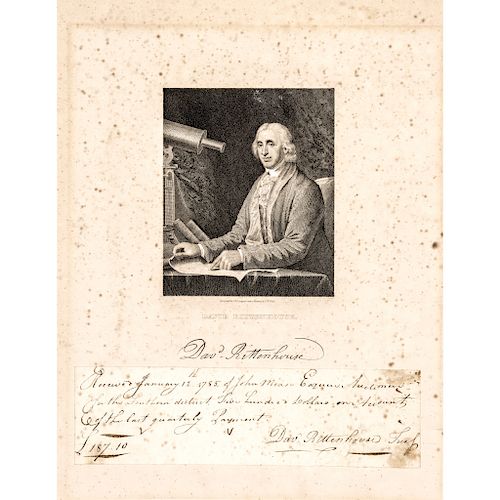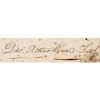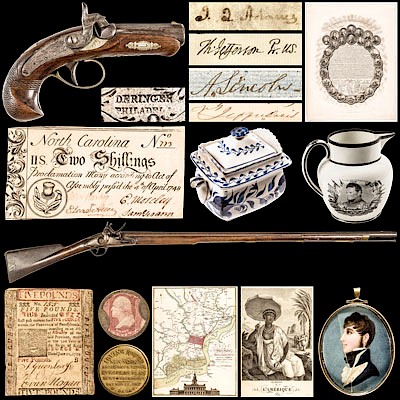1785 David Rittenhouse Signed Manuscript Document From John Mease, PA Auctioneer
Lot 88
Categories
Estimate:
$2,000 - $3,000
Absentee vs Live bid
Two ways to bid:
- Leave a max absentee bid and the platform will bid on your behalf up to your maximum bid during the live auction.
- Bid live during the auction and your bids will be submitted real-time to the auctioneer.
Bid Increments
| Price | Bid Increment |
|---|---|
| $0 | $10 |
| $200 | $20 |
| $300 | $25 |
| $500 | $50 |
| $1,000 | $100 |
| $2,000 | $200 |
| $3,000 | $250 |
| $5,000 | $500 |
| $10,000 | $1,000 |
| $20,000 | $2,000 |
| $30,000 | $2,500 |
| $50,000 | $5,000 |
| $100,000 | $10,000 |
| $200,000 | $20,000 |
| $300,000 | $25,000 |
| $500,000 | $50,000 |
About Auction
By Early American History Auctions
Oct 19, 2019
Set Reminder
2019-10-19 12:00:00
2019-10-19 12:00:00
America/New_York
Bidsquare
Bidsquare : Historic Autographs-Currency-Political-Americana-Militaria-Guns
https://www.bidsquare.com/auctions/early-american-history-auctions/historic-autographs-currency-political-americana-militaria-guns-4513
326 Lots of Rare, Historic Autographs, Americana, Civil War Era, George Washington, Abraham Lincoln, Black History, Revolutionary War Era, Colonial America, Federal Period, War of 1812, Colonial Currency, Indian Peace Medals & more... Early American History Auctions auctions@earlyamerican.com
326 Lots of Rare, Historic Autographs, Americana, Civil War Era, George Washington, Abraham Lincoln, Black History, Revolutionary War Era, Colonial America, Federal Period, War of 1812, Colonial Currency, Indian Peace Medals & more... Early American History Auctions auctions@earlyamerican.com
- Lot Description
Autographs
David Rittenhouse Signed Document From John Mease
DAVID RITTENHOUSE (1732-1796). Historic American Astronomer, Revolutionary War Patriot, Inventor, Treasurer of Pennsylvania, George Washington appointed him as First Director of the United States Mint, President of the American Philosophical Society.
January 12, 1785-Dated Post Revolutionary War, Manuscript Document Signed, "Dav. Rittenhouse" as Treasurer, being a Receipt, of "John Mease, Esquire Auctioneer for the Southern district, Two Hundred Dollars on Account, Very Fine. A clockmaker by trade, Rittenhouse built mathematical instruments and, it is believed, the first telescope in the United States. He also introduced the use of natural spider webbing to form the reticle (system of cross hairs) in telescope transits and other position-measuring instruments. Rittenhouse was highly esteemed as a surveyor; he supervised the establishment of the boundaries between Pennsylvania and Maryland, New Jersey, New York, and the Northwest Territory, and parts of those between New York and New Jersey and between New York and Massachusetts. Rittenhouse was the treasurer of the state of Pennsylvania from 1777 to 1789. In 1792 President George Washington appointed him the First Director of the U.S. Mint in Philadelphia, a position he held for three years. He was elected a fellow of the Royal Society of London in 1795 and served as President of the American Philosophical Society from 1791 until his death.
This rare Signed Receipt measures 2" x 7.5" being mounted for prior display to a 10.5" x 8.25" Engraved Portrait Print of David Rittenhouse as an Astronomer with his telescope at left by J.B. Longacre after the famous painting by Charles W. Peale, with facsimile signature below. John Mease, Esquire, was officially appointed "Auctioneer" for the district of Southwark, Pennsylvania by the Supreme Executive Council for which David Rittenhouse served a Treasurer. This is an original Document dated 1785, where David Rittenhouse, Treasurer of Pennsylvania, has signed a receipt to John Mease, for funds received from auctioning services of the last quarterly Payment. Scattered foxing specks and tone. Boldly Signed in brown ink at the conclusion "Dav. Rittenhouse Treas." measuring over 3" long with his flourish below.
David Rittenhouse (April 8, 1732 - June 26, 1796) was a renowned American astronomer, inventor, clockmaker, mathematician, surveyor, scientific instrument craftsman, and public official. Rittenhouse was a member of the American Philosophical Society and the first director of the United States Mint.
David Rittenhouse made many breakthroughs of importance to the United States. During the first part of his career he was a surveyor for Great Britain, and later served in the Pennsylvania government. His 1763-1764 survey of the Delaware-Pennsylvania border was a 12-mile circle about the Court House in New Castle, Delaware, to define the northern border of Delaware. Rittenhouse's work was so precise and well-documented that it was incorporated without modification into Charles Mason and Jeremiah Dixon's survey of the Pennsylvania-Maryland border.
Rittenhouse was admired by many colonial Americans and scientists, including Dr. Benjamin Franklin, Thomas Jefferson, and John Adams. On February 24, 1775, Rittenhouse delivered a lecture on the history of astronomy to the American Philosophical Society, in which he linked the structure of nature to the rights of man, liberty and self-government. Rittenhouse also used the occasion to decry slavery. So impressed were those in attendance that the American Philosophical Society commissioned the speech to be printed and distributed to delegates of the Second Continental Congress when they arrived in 1776.
David Rittenhouse was treasurer of Pennsylvania from 1777 to 1789, and with these skills and the help of George Washington, he became the first director of the United States Mint.
- Shipping Info
-
Early American provides in-house worldwide shipping. Please contact us directly if you have questions about your specific shipping requirements.
-
- Buyer's Premium



 EUR
EUR CAD
CAD AUD
AUD GBP
GBP MXN
MXN HKD
HKD CNY
CNY MYR
MYR SEK
SEK SGD
SGD CHF
CHF THB
THB













